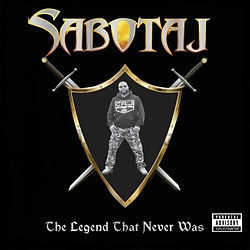
Sabotaj’s introduction to the world of hip hop can be traced back to 1979. That year, the Sugarhill Gang released its groundbreaking track “Rapper’s Delight,” which Sabotaj cites as “a song that was everything to kids growing up in the hood.”
ABOUT Sabotaj:
Potions of Rhyme and Time: The Making of a Legend
Leonard Fischer, artistically known as Sabotaj, often looks to the past for inspiration. He turns to films, videos, cartoons, spoken and written word, but none more passionately than music. As an artist, he dissects and interprets these art forms to carefully produce his reflections and rhymes. He is a disciple of the school of hip hop. Sabotaj is determined to make his mark as the legend that never was.
Early Life
Sabotaj’s introduction to the world of hip hop can be traced back to 1979. That year, the Sugarhill Gang released its groundbreaking track “Rapper’s Delight,” which Sabotaj cites as “a song that was everything to kids growing up in the hood.” The hood he references is South Central Los Angeles where he and his younger brother were raised by his mom and grandmother from a very young age. Their parents divorced when he was just 3 years old, his father remarried about 5 years later and eventually moved to Dallas. Sabotaj recalls the subsequent years after his father’s move as the roughest years of his youth.
Despite the difficult upbringing, there was always one channel through which he could escape. “Rapper’s Delight” opened his eyes and ears to hip hop music and its culture. Through Los Angeles-based radio station KDAY and its influential radio DJ Greg Mack, hip hop and rap had fully infiltrated the airwaves by the 1980s. KDAY introduced Sabotaj to hip hop pioneers such as Eric B. & Rakim, KRS-One, Public Enemy, The Juice Crew and Biz Markie. By the mid-1980s, West Coast hip hop had arrived and with it came Ice-T, Eazy-E, N.WA., King Tee, Tone Loc and several others that Sabotaj grew to greatly admire. As hip hop entered the mainstream so did films about its inception, culture and significance. Sabotaj recalls watching 1984’s “Beat Street,” a film about New York City’s hip hop culture, nearly every day for months. A year later, “Krush Groove” was released, which introduced hip hop enthusiasts to Russell Simmons and Rick Rubin and their hugely successful venture: Def Jam Recordings. This film also spotlights Run-DMC and their rise to fame. These two films significantly influenced him; and according to him, “triggered something deep inside of me.”


One particular day in 1988, Sabotaj’s friends, who would often dee-jay at house parties, encouraged him to write a verse for an upcoming party. He stepped up to the plate and started writing. Sabotaj recited the verses to his friends who were left in shock at what he had produced. It was at this critical moment in his life where he recalls telling himself, “Wow, I can do this.” He has never stopped writing since. At around the same time he came across a track called “My Philosophy” by Boogie Down Productions. He cites the golden era of hip hop and “My Philosophy” as the foundation through which his artistry was born.
Initially, Sabotaj would perform under the monikers Lenwise and Lenwise The Chief. The latter being a tribute to his ethnic background, which is Black mixed with Cherokee Indian. However, once in college his rapping style gradually metamorphosized – as did his artistic persona. His rhymes had become more intense, cut throat and ruthless to match the tone of hip hop at the time. While hanging out with a friend and after weeks of brainstorming, the word Sabotage flashed up on the TV screen in a commercial and so did a lightbulb in their brains. As Sabotaj he took his craft to the next level both personally and professionally.
SABOTAJ’s album

Sabotaj singles

Sabotaj IN PRESS
-
Music Spotlight: Sabotaj – Powers To Be Legendary (Video + Interview)
-
EXCLUSIVE ARTIST TO WATCH INTERVIEW WITH DOPE LA RAPPER “SABOTAJ”
-
Sabotaj Talks Growing Up in South Central L.A., “The Legend That Never Was” Album & More [Interview]
-
Sabotaj: “The 5 Elements” – driving home his message of hip-hop revival




.png)




